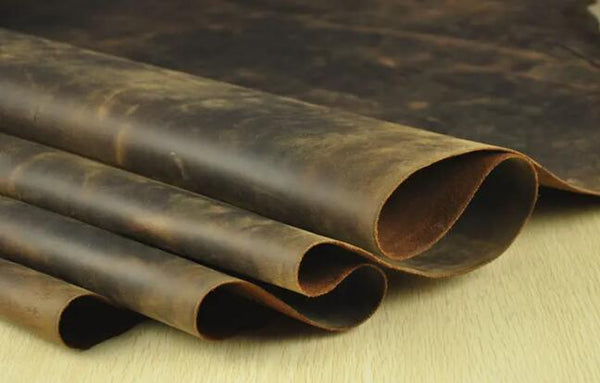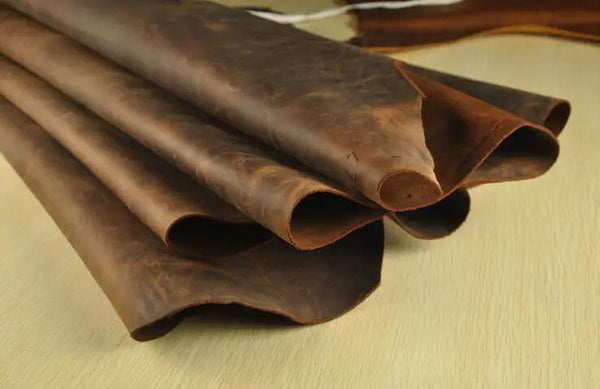Your cart is currently empty
How To Distress Leather? The Fast-Tracking Method
After being distressed, the leather will have a unique appearance that a brand-new leather wallet can't match. Many people would instead use distressed calfskin items than "regular" ones. If you have any leather wallets you'd like to distress; you shouldn't hesitate to do so, as the process is simple.
Leather can be aged in several different ways. Leather can be "distressed" to give older items made from animal hides a vintage feel and aspect.

How is distressed leather different from other leather?
Some leather goods are museum-worthy in appearance. The item is shiny and immaculate, making it ideal for public viewing. Distressed leather, on the other hand, has been purposefully damaged and worn to give the appearance of age and weathering.
A piece of distress leather belongs in a gallery. To this extent, each piece of distressed leather has its own identity, history, and legacy. Distressed leather's assets are its audacity and durability, making each item a unique relic.
The wear and tear of travel and exploration and the weight of potential danger are all intended functions of distress leather.
After all, your company's name, Andar, means "to carry," and you design each item so that it can be carried through the unknown, so that it can show the scars and wear that coming to terms with life's perils entails, and so that it can deliver those scars and wear with no shame.
Distressing leather gives it a weathered and worn (or antique, if you like) appearance and increases its durability by making it less prone to cracking and scratching.
Why do people like distressed leather?
This is because only full-grain leather can be processed into high-quality distressed leather, which has a stretched and vintage appearance due to the inclusion of the hide's inherent properties, including healed scars, scratches, and creases, all of which are seen as positive qualities.
Second, scratches can sometimes be repaired on distressed leather. If your distressed leather goods ever become scratched, you may remove the damage by rubbing the affected area with your fingers or by applying leather care wax to the scratch and rubbing it in.
Last but not least, damaged leather needs fewer repairs. Compared to other types of leather, it takes almost no upkeep because the oil in the hide prevents the leather from drying out and looking shabby over time.

What do you use to distress leather?
To hasten the deterioration of your leather garment, you must first acquire the appropriate implements. To successfully weather leather, keep these items on hand:
- A bottle of 90% rubbing alcohol
- Sandpaper
- A heavy bristled brush
- Rubber gloves
- Shoe polish
- Shoe wax
Step 1: Put some rubbing alcohol on it.
Rubbing alcohol is the first step in making your leather look old and worn. Put some rubbing alcohol (at least 90%) into a spray bottle and use that to mist the leather. The leather will become more pliable after being dampened, making it suitable for distressing. Remember that leather should only feel slightly damp to the touch, not drenched.
Step 2: Rough up your leather.
After soaking the leather with rubbing alcohol, the fun begins: beating it to a pulp. Knead, crease, and crumple any leather item to release any pent-up frustrations. This will give it the wrinkles and creases characteristic of leather used.
Step 3: Use sandpaper to scratch up the leather
Sand the spots that constantly wear out first (edges, seams, bottoms, corners, etc.). As a result, your leather will have the appearance of actual age.
Step 4: Use a bristled brush to go over your leather again.
If you want your leather to look even more weathered, you can replicate the sandpapering process with a stiff bristles brush. Scuff and scar the fabric permanently by moving the brush in various directions. Focusing on wear and strain on weak spots is worth the effort.
Step 5: Put shoe wax on your work to seal it.
After the leather has dried from being treated with rubbing alcohol, you may protect its aged appearance with a coat of shoe wax. Shoe wax can be applied to the leather's surface using a cloth or a toothbrush to provide an extra layer of defense. To avoid wasting wax, rub it as much as possible before wiping it off.
This is all about how to distress leather.
Why distressing your leather is a good idea?
Determining your motivation for distressing leather is crucial before you grab your tools and work on your leather garment. In contrast to other trendy items, such as ripped jeans and holey T-shirts, distressed leather has been around for a while and shows no signs of going away.
Particularly, distressed leather jackets have become an enduring fashion style that has been adopted by nearly every generation and has come to represent the passage into adulthood. The distressed leather also has a tale to tell, and the worn, vintage vibe it exudes makes every ensemble look better.

How to distress leather boots?
Distressed leather boots, which give off an entirely distinct vibe, are a wardrobe must for any grownup. Roughen up the look of your leather boots with some rubbing alcohol. This concludes the discussion. Here are the measures you should take.
1. Put the rubbing alcohol in a bottle that can be sprayed.
2. Spritz the leather of your boots lightly. Instead of a spray bottle, you can use a toothbrush or an old towel.
3. No need to completely submerge the leather in alcohol; dampen it.
4. When the alcohol dries, it will give the leather a worn look.
How do you age leather with wax?
1. Clean the boot first to make sure it's not dirty.
2. Take the wax and lightly rub it in a circular motion all over the boot.
3. Rub it all over the boots again, but apply more pressure where you want the shoes to look more worn.
4. Get water, dip your fingers, and smooth the material.
How to take care of items made of distressed leather?
Full-grain leather is artificially aged using various processes to get the distressed look. Products from distressed leather are easy to care for and don't require specialized equipment or leather cleaner. To maintain your distressed leather items, follow these simple instructions.
Avoid going near the water at all costs.
Since distressed leather is full-grain leather without a protective covering such as a water repellent, it is even more crucial to maintain your distressed leather product away from water.
If you spill something damaging on it, like water, cola, or coffee, wipe the area quickly with tissue paper or a water-absorbing cloth, but do not rub the area, as this can spread the liquid.
Then, let the water evaporate naturally, as this will inflict minor damage. After that, finish with wax or mink oil.
- Cleaning Leather to Remove Grime
Damaged leather can be easily cleaned by wiping it down with water and soap. This is a process that, in my opinion, is only necessary before the wax is applied to damaged leather.
- To protect worn leather, use wax.
After a few weeks of use, distressing leather with wax is an essential step. Leather will be hydrated, protected from drying out, and given a weathered look.
If you want to distress leather, all you need is some natural leather wax, and you can skip the conditioner. In addition to using a leather conditioner, mink oil is excellent for rehydrating worn leather.
In addition, here are some further precautions you may take to protect your used leather goods.
- Don't expose damaged leather to the sun.
- Don't stuff leather with newspapers.
- Never use water to clean leather.
Can you beat up faux leather?
Though it is not genuine leather, distressing imitation leather is rugged. To achieve the desired look while using faux leather, try these procedures.
- Buy a cleaning wipe with a rough surface. Start scrubbing the fake leather in a circular motion with the rough cleaning wipe.
- Start at the bottom and use the wipe to scrub small pieces of the fake leather at a time. Use a lint-free cloth to dry the leather piece.
- Keep moving up and rubbing the leather with the wipe until you get the look you want.
How do you get leather to look less shiny?
You can dull leather without pricey creams by rubbing it with sandpaper.
- Carefully use grade sandpaper to scratch the leather.
- Rub the parts of the foot that are more likely to hurt, like the toes, seams, and heel corners.
How to distress a leather jacket with a knife?
Use a sharp knife to damage the leather in strategic places to simulate wear and tear. If you do this, utilize a cutting board and proceed with extreme caution.
A deep cut might ruin the leather, so it's best to work with little, deliberate motions. Try distressing the edges, seams, and tabs of the pockets.
- Use A Hammer:
Distress your leather jacket with a hammer if you have one. This is a fantastic method for distressing huge areas to give them a more natural, weathered appearance.
To get a distressed look, beat the leather with a hammer. For more intense discomfort, you can apply additional pressure.
- Use Chisels:
Chisels are another excellent tool for distressing leather jackets, as discussed earlier. They come in various sizes and shapes to allow you to target specific portions of the garment for pain. Take a knife to the jacket's seams, pockets, and wherever else you want for that worn effect.
- Use Heat:
You can damage leather more easily by first heating it in certain spots with a lighter or candle. The area affected by this will appear more worn as a result. It will help if you exercise extreme caution to avoid burning the leather.
- Use A Blowtorch:
Using a blowtorch is the most powerful method of distressing a leather jacket. Use this to your advantage if you're going for a more vintage look.
Using the blowtorch, you may quickly age the parts you want to look worn down. Again, exercise extreme caution, as you may easily ruin or even burn your jacket if you're not careful.
How to distress a leather jacket if you don't have any sharp things to use?
Distressing leather doesn't have to include using knives or other sharp objects. Sanding it down is one option. A further option is to use a heat gun to make bubbles in the leather.

Avoidance Checklist
There are several ways to achieve a worn look when working with leather. First, you should familiarize yourself with the things you absolutely must not do while distressing leather.
To keep your leather in good condition, you should never rub it with sandpaper. It could be assumed that using sandpaper to smooth and polish the surface would achieve these goals. However, doing so would ruin the quality and beauty of the leather.
Shaving the animal's skin removes any scars or scrapes that may have occurred before the leather was tanned. The calfskin's surface is the most stable part of the hide, which could cause the material to deteriorate.
Similarly, this is not the best method to create a distress leather wallet. For the same reason that wire brushes can ruin a freshly applied coat of color, they are as gentle as sandpaper. Remove your cowhide by sanding or wire brushing it.
Also, avoid the temptation to "distress" your leather wallet by placing it near a flame. Despite its health risks, smoking Forever synthetic modifications can be made to the structure of calfskin by smoke, and the odor is unlikely to fade away for an extraordinarily long period.
If you want to leave a trail of stale smoke wherever you go with your money, that's your prerogative. To avoid this, keep smoke and, more importantly, heat your cowhide. Similarly, don't try to light your cowhide on fire.
How do you distress leather with rubbing alcohol?
Apply a thin layer of alcohol to the leather, and start working. Prolong, move, work, manipulate, and knead it. After repeating the process a few times, you'll have a good grasp of what's involved.
Avoid drinking excessively without delay. Make an effort to codify this practice. Use only a tiny amount of rubbing alcohol at a time and rub gently to avoid damaging the leather and affecting the color.
To the same effect, not all leather is compatible with rubbing alcohol, so test a small area first. Apply a small amount to your calfskin in a strategic area using a white cloth and wait for it to dry.
If there is no spillage, excessive coloring, or other unfavorable results, it is acceptable to proceed.
To do the same for leather, you can use rubbing alcohol in a spray bottle and lightly mist it. You don't want to soak your wallet, but a light spraying with rubbing alcohol will help dry up the cowhide and get a long-lasting look underway.
Unfortunately, Not All Leather Can Be Aged!!!
Keep in mind that not all leathers respond well to the distressing technique. This is because some leathers are not durable enough to withstand the painful process.
Because of their tight fibers and extreme durability, only full-grain and top-grain leather can be distressed.
It is not advised to distress suede or genuine leather because their fibers are much looser and more readily broken than synthetic leather's, which is why synthetic leather is typically used.
Dangers of manually distressing leather
Use and age are the two main contributors to the leather's distressed appearance. Even if you can get this effect without using the item for years, the process of leather distressing, which involves putting the thing through a lot of stress, can ruin it in a way you don't want.
Since suede, genuine, and even synthetic leather cannot endure such stress, you should avoid using these techniques. Although the materials may hold together for a while, the natural fibers in suede and genuine leather are too flimsy, leading to rapid wear and tear.
Is it expensive to buy distressed leather?
The high cost of distress leather directly results from its construction from genuine, full-grain hides. You might not care much for branded bags, but those close to you might pressure you to buy and carry a high-quality branded bag with a "distressed leather" label.
Vintage vs. Distressed Leather
The most distinguishing characteristic of vintage leather is its burnished patina, which indicates that it is whole grain.
It is impossible to replicate the authentic look of this leather because it is one of the most accurate on the market. Typically, the age of vintage leather is anywhere from 20 to 100 years.
To create crazy horse leather, full-grain leather is subjected to a series of treatments that make it stronger and more weather-resistant without altering its signature softness and supple patina.
The leather will eventually be classified as old or vintage-inspired, making it ideal for use in manufacturing vintage bags.
In reality, the crazy horse leather's scratches and wrinkles offer a lovely layer of color to the leather. Genuine full-grain leather will age to a smooth, polished patina.
Conclusion
Inquiring minds want to know more about distress leather. To sum up, distress leather is a type of leather that has been purposefully damaged or scarred to give the appearance of age and weathering, transforming it from ordinary glossy leather into a work of art.
And if you were to get caught gaming in an old parlor with the wrong kind of individuals, they would be more interested in taking your wallet than the contents.
Shop our collection of:
Leather Embossed Journals | Refillable Leather Journals | Leather Sketchbook | Customized Leather Portfolios | Leather Refillable Planner | Leather Bags For Men | Leather Bags For Women
Related Blog Posts:




